
-
Find the right food for your petTake this quiz to see which food may be the best for your furry friend.Find the right food for your petTake this quiz to see which food may be the best for your furry friend.Featured products
 Puppy Food
Puppy FoodHill's Science Plan Puppy Multipack Wet Dog Food with Chicken & Beef are complete premium pet foods for growing puppies from weaning until 1 year old and for pregnant and nursing dogs. Your puppy will love these deliciously smooth and savoury minced loaves, formulated for balanced nutrition and overall health.
Shop Now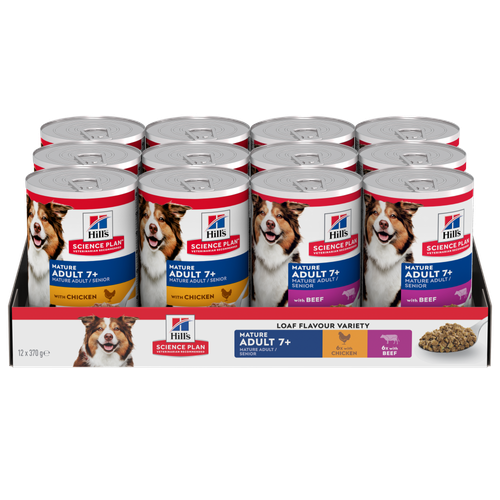 Mature Adult Dog Food
Mature Adult Dog FoodHill's Science Plan Mature Adult Multipack Wet Dog Food with Chicken & Beef are complete premium pet foods for mature adult dogs from 7 years. Your dog will love these deliciously smooth and savoury minced loaves, formulated to deliver the appropriate amount of energy to support the needs of adult dogs.
Shop Now Adult Wet Dog Food with Beef
Adult Wet Dog Food with BeefHill's Science Plan Adult Multipack Wet Dog Food with Chicken, Beef & Turkey are complete premium pet foods for adult dogs from 1 year. Your dog will love these deliciously smooth and savoury minced loaves, formulated for balanced nutrition and overall health.
Shop NowFeatured products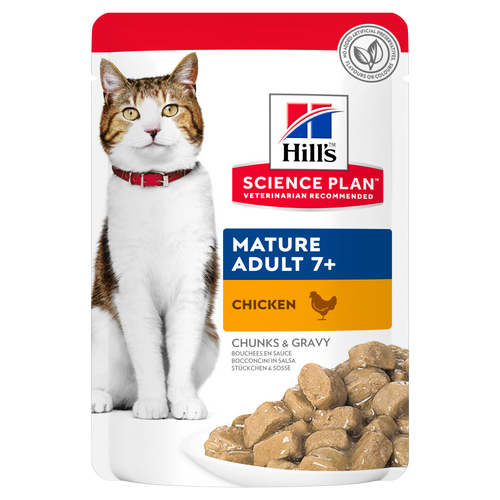 Mature Adult Wet Cat Food with Chicken
Mature Adult Wet Cat Food with Chicken
Tender chicken chunks in gravy for mature adult cats. Made with easy-to-digest ingredients, high-quality protein for lean muscle maintenance and antioxidant vitamins C+E for optimal health.
Shop Now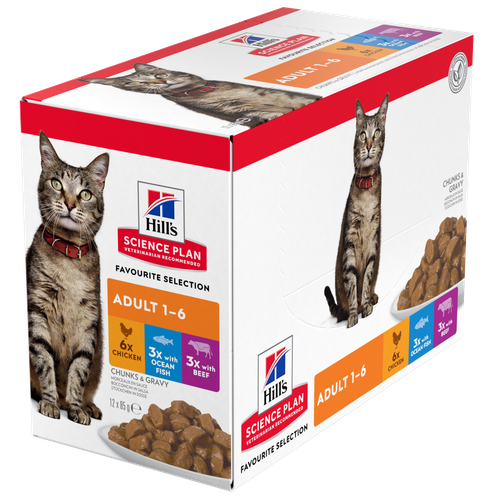 Adult Multipack Wet Cat Food with Beef, Ocean Fish & Chicken
Adult Multipack Wet Cat Food with Beef, Ocean Fish & ChickenTender chunks in gravy for cats, with high-quality protein to maintain lean muscle. With vitamin E and omega-3s & -6s for healthy skin and balanced minerals to support healthy vital organs.
Shop Now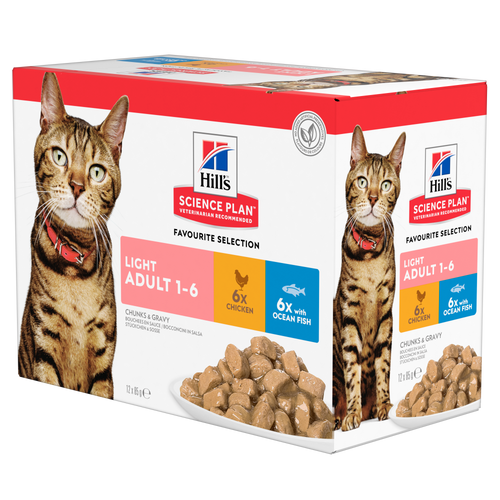 Light Adult Multipack Wet Cat Food with Chicken & Ocean Fish
Light Adult Multipack Wet Cat Food with Chicken & Ocean FishTender chicken chunks in gravy for cats, with L-carnitine and fewer calories for ideal weight management. Packed with high-quality protein, omega-6s, and vitamin E for shiny fur and healthy skin.
Shop Now -
Dog
- Dog Tips & Articles
-
Health Category
- Weight
- Food & Environmental Sensitivities
- Urinary
- Digestive
- Joint
- Kidney
-
Life Stage
- Puppy Nutrition
- Adult Nutrition
- Senior Nutrition
Cat- Cat Tips & Articles
-
Health Category
- Weight
- Skin & Food Sensitivities
- Urinary
- Digestive
- Kidney
-
Life Stage
- Kitten Nutrition
- Adult Nutrition
Featured articles Show some love with wet foods: a great choice for pets with health issues
Show some love with wet foods: a great choice for pets with health issuesShow some love with wet foods: a great choice for pets with health issues.
Read More The Incredible Science Behind Your Pet's Microbiome
The Incredible Science Behind Your Pet's MicrobiomeLearn what your pet's microbiome is, how it contributes to your pet's gut and overall health, and why nutrition is important in maintaining healthy microbiomes.
Read More The Right Diet For Your Pet
The Right Diet For Your PetIn people, the right diet is very important. If you are eating the wrong way for your metabolism, activity level, age and lifestyle you could end up with health issues.
Read More -


Cats are naturally active creatures that get lots of exercise in the wild. However, this is not always the case for our domesticated feline friends, especially indoor cats. This lack of activity can take a toll on a cat’s physical wellbeing, putting them at risk of conditions like arthritis and obesity. In fact, according to the PDSA, over a third of the nation’s cats are now overweight. Exercise is essential for your cat’s mental wellbeing too, and Blue Cross warns that a lack of activity can lead to boredom and behavioural issues like scratching and aggression.
One way to keep your indoor cat active and give them the physical and mental stimulation they need is a scavenger hunt. Cats love to hunt, so this is a great way to appeal to those natural instincts and get them moving. Read on to learn how to keep your indoor cat active and entertained with this fun game.
Food scavenger hunts: A fun way to keep your indoor cat active
A food scavenger hunt combines your cat’s natural hunting instinct and their love of treats! Searching out the treat gets them moving, while the problem-solving element keeps your cat mentally engaged and laser-focused. And when they finally sniff out their reward, they get to experience the satisfaction of the “catch.” It’s also fun to watch your cute, fluffy feline friend unleash their inner predator!
How to plan the perfect food scavenger hunt
First, decide what you want your cat to hunt for. A good option to start with may be a small handful of their favourite treats, each placed in their own hiding spot around the house. You might also use a few pieces of your cat’s regular kibble, especially if your cat is eating a therapeutic food. You can always make some treats from your cat’s prescription food to add some variety to the mix. (Battersea Dogs & Cats Home advises that treats, whether they’re given as rewards or used in a scavenger hunt, should be counted as part of your cat’s daily calorie intake.)
Let the hunt begin!
Your cat has twice as many scent receptors in their nose as you do, and can smell about 14 times better, according to Companion Life. Let them smell the treats first, and they’ll be able to use this incredible sensory superpower to track them later on.
Start by simply placing their treats in easy-to-see hiding spots. As they start to get the idea of the game, take the difficulty up a notch. Let them watch you put the treat in its hiding place; your cat might not be able to see it anymore, but they’ll know you’re up to something and will head to the area to sniff around.

Once your cat has the hang of the game, place them in another room while you hide the treats and then let them in to search. Try to be clever but cautious when choosing hiding spots, avoiding areas that you don’t want them to regularly wander into (e.g. kitchen counters or areas with breakable items). Some great places to consider are:
- Next to (or even inside) a toy.
- On a high shelf.
- In an empty box.
- On a cat tree.
- Under a bed or sofa.


Tasty Tips
Best times for a cat scavenger hunt
One of the best times for a cat scavenger hunt is right before a regular mealtime, when you know they’re hungry and more likely to be engaged. You can also start a scavenger hunt during your cat’s active periods – at the beginning or end of the day, according to the PDSA – or if you notice them becoming energetic or restless.
You should also make sure to keep an eye on your cat during the hunt. Not only is it fun for you to watch, but you want to stay close in case your cat gets frustrated or distracted, or they pick up something else by accident.
It's also a good idea to keep a note of where you've hidden the kibble or treats. If your cat gets full or bored, they may leave a few pieces of food uneaten. Remembering where you've placed it will stop you, the ants, (or your cat) from finding old, expired food around your house.
More stimulating activities for indoor cats
Looking for other fun exercises to keep your indoor cat active? Try these ideas:
- Teaser toys. Wand toys with ribbons or feathers can be used to create a fun cat hunting game.
- Laser pointers. These are ever-popular with cats, but be sure to keep the light away from their eyes and end sessions on a toy or treat to prevent frustration!
- Balls. Cats can’t resist chasing a ball as it rolls by them!
- Motorised toys. Cats will sprint after these, too!
- Puzzle feeders. Requiring your cat to solve a problem to release a treat, these puzzle toys are one of the most engaging ways to prevent cat boredom.
- DIY obstacle courses. Build a circuit for your cat that appeals to their natural instincts to climb, run, jump, pounce and hide. Think hiding places, tunnels, high spots and perches.
Tips for long-term success
Cats need regular exercise to remain fit and healthy, so you may need to get creative to keep your indoor cat active. Try the following tips to set you both up for success:
- Monitor their activities. See how your cat responds to different exercises and tailor your cat’s physical activity to their interests and abilities.
- Combine activities. Introduce new elements to maintain your cat’s interest over time. For example, you could combine a scavenger hunt with an obstacle course.
- Cater to your cat’s needs. Senior cats, overweight cats, and those with certain health conditions may need a more careful approach to exercise. Consider low-impact activities for these cats, and check in with your vet to make sure they’re suitable.
A scavenger hunt is a great way to strengthen your bond with your cat, and it can be a valuable source of physical and mental stimulation too. If you’re looking for a way to keep your indoor cat active, grab those treats and let the hunt begin!
Frequently asked questions about scavenger hunts to play with your cat
How often should I organise scavenger hunts for my cat?
There’s no hard-and-fast rule, but be mindful that if you try to play too frequently, your cat may get bored. Try a couple of times a week and if your cat seems to be losing interest, take that as a sign to play less frequently or mix up their activities.
What if my cat doesn’t seem interested in the hunt?
Not sure how to make your cat hunt for food? It could be that your cat doesn’t quite understand the game. Try showing them and letting them sniff the treats first, and once you have their attention, make sure to hide them in an easy-to-see spot. As your cat gets the hang of the game, gradually increase the difficulty of the hunt, hiding cat food around the house. If your cat still doesn’t seem interested, try another activity to get them moving, such as an obstacle course, a puzzle feeder, or a wand or teaser toy.
Can I use my cat’s regular food for scavenger hunts?
Yes, you can hide pieces of your cat’s kibble if you prefer, especially if your cat is eating a therapeutic food. You can make some treats from your cat’s prescription food to add some variety to the mix.
What are some signs that my indoor cat needs more activity?
Physical signs that your indoor cat is not active enough include weight gain, reduced jumping up,, or lethargy. Obesity, joint pain and boredom can cause changes in behaviourike scratching furniture, excessive vocalisation or aggression towards other pets or family members. If you notice any changes to your cat’s health or behaviour, check in with your vet just to be on the safe side.


Kara Murphy is a freelance writer and pet parent who lives in Erie, Pa. She has a goldendoodle named Maddie.
Related products

Tender chunks in gravy for cats, with high-quality protein to maintain lean muscle. With vitamin E and omega-3s & -6s for healthy skin and balanced minerals to support healthy vital organs.

Tender chicken chunks in gravy for cats, with L-carnitine and fewer calories for ideal weight management. Packed with high-quality protein, omega-6s, and vitamin E for shiny fur and healthy skin.

Tender chicken chunks in gravy for mature adult cats. Made with easy-to-digest ingredients, high-quality protein for lean muscle maintenance and antioxidant vitamins C+E for optimal health.
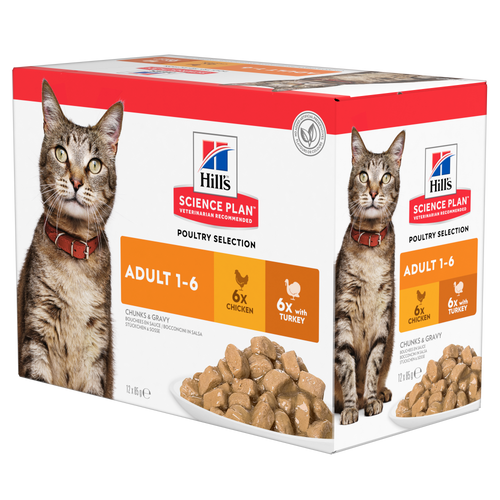
Related articles

Feeding time can be a wonderful bonding opportunity for you and your cat. Find out how to make the most of it and create a healthy habit with HIll's Pet UK.

Discover what you can do to spot and support a sensitive cat stomach. See what routines and food you can implement to help your cat be happy and healthy.

Find the right Hill

Find out about how you can support your cat's digestion to boost overall health. Diet is key to a long and happy life for your cat, so discover what you can do.

Put your cat on a diet without them knowing
Our low calorie formula helps you control your cat's weight. It's packed with high-quality protein for building lean muscles, and made with purposeful ingredients for a flavourful, nutritious meal. Clinically proven antioxidants, Vitamin C+E, help promote a healthy immune system.
Put your cat on a diet without them knowing
Our low calorie formula helps you control your cat's weight. It's packed with high-quality protein for building lean muscles, and made with purposeful ingredients for a flavourful, nutritious meal. Clinically proven antioxidants, Vitamin C+E, help promote a healthy immune system.

